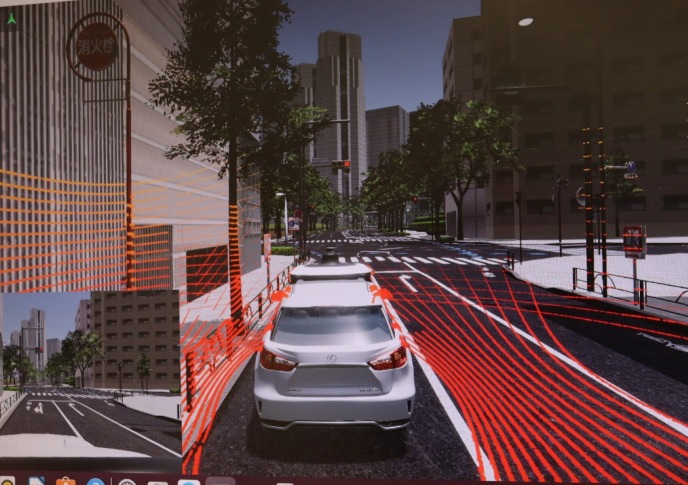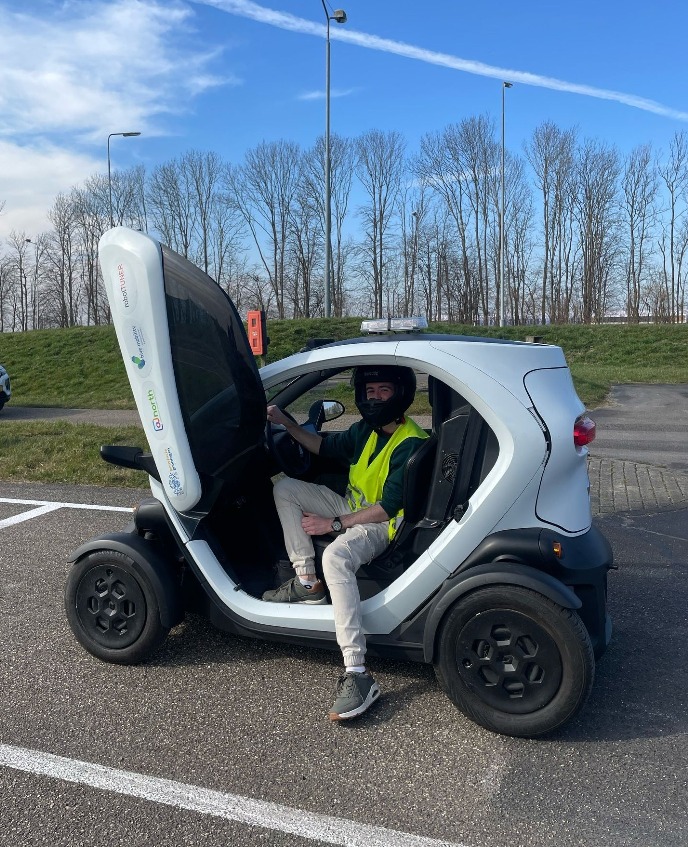Flexible and fanatical: Students roll up their sleeves for self-driving car
A brand-new team from the University of the North is gearing up again for the 2025 edition of the RDW Self Driving Challenge (SDC). In the team called 'Lord of the Roads', students from educational institutions Noorderpoort, Hanze University of Applied Sciences (Hanze UAS), and the University of Groningen (UG) are working together to build a self-driving car. Team leader Laura María Quiros shares more about their joint efforts.
Text: Froukje Duursema, Corporate Communication UG

Having gained experience at Makercie and the Hanze Racing Division (HARD), autonomous transportation is not new to Quiros. She helped build an electric car and even has experience with autonomous flight. For some time now, Quiros has been into mechatronics, which has taught her a lot about control techniques. The Self Driving Challenge is a perfect time for her to apply the acquired knowledge. Moreover, the knowledge from her studies in Artificial Intelligence also comes in handy.
The student team is competing in the Open Category again this year. This means that they must supply their own car, but also have more freedom in developing the system of the self-driving vehicle. Just like last year, the team is sponsored by robotTUNER and they provided her with a Renault Twizy to work with.
Getting the cart rolling
The competition has different goals each year. Quiros explains their tasks for this year: ‘We have to follow a fixed route, the layout of which we already know. Along the way, we encounter traffic signs, among other things, prompting us to consider speed limits and stop signs. The car must also be able to stop at traffic lights, pedestrians crossing, and stationary cars.’ In addition to her leadership role on the team, Quiros is also involved in developing the self-driving car. In this role, she mainly works on the visual perception system of the self-driving car. ‘We are reusing our sponsor's YOLOV model, which is designed to recognize objects. This will soon enable our car to recognize traffic signs and traffic lights as well.’

A bumpy ride
The team has encountered a number of obstacles along the way. ‘Working in a multidisciplinary team takes some getting used to because of the different knowledge and approaches of the team members. This can be a bit difficult with respect to timing.’ Another example is that the Twizy is located at the Noorderpoort site, while most of the team works at Zernike. This creates challenges because of limited flexibility and facilities. In addition, the team is experiencing difficulties integrating the simulation environment with the code provided by the sponsor. ‘When we want to check whether our code works, we have to connect remotely to the physical car to execute it. This only works if someone is on site with the car at Noorderpoort. Quiros explains that this sometimes makes physical collaboration a bit difficult, but overall, they get along well.
Quiros also explains that the team is not allowed to modify the construction of the car for safety reasons. This has also caused some difficulties because it was clear from the start of the competition that the team needed a so-called spring-loaded emergency stop switch. 'This works by pressing a button that activates a spring, which pushes against the wheel, creating friction and preventing the car from moving forward.’ Instead, the team has an electric switch that runs on a battery. ‘In principle, you can stop the car by pressing the switch. However, the problem with this is that when you stop the power, there will always be a little bit of electricity left, which can cause malfunctions.' Fortunately, the team has a number of students from the Master’s degree programme in Systems & Control who know how to deal with this.

Joining forces
Quiros explains the collaboration between the various educational institutions as follows: ‘The students at Noorderpoort are mainly concerned with technology. Their task at the moment is partly to store and maintain the Twizy. They are also working on another multifunctional vehicle, for which they will try to use the code for the Twizy.’ Some of the students from Hanze UAS have played a key role in designing the emergency stop switch. Other Hanze students are working on the visual perception system part, as is Quiros. ‘They are busy coding and researching the best algorithm. The students from the UG, on the other hand, come from a wide variety backgrounds, such as Industrial Engineering, Biomedical Engineering, Mechanical Engineering, and AI. 'Everyone is skilled and important in their own way. Moreover, we can often laugh together when something goes wrong.’
AI in action
What Quiros applies most from her studies is her knowledge of the AI lifecycle. ‘My teammates often think of AI as large models, things that are difficult to implement. I try to make it more feasible by thinking about a simpler model that is accurate enough. We then compare this to better models so we can optimize our own model. Quiros also highlights her programming skills as one of the most useful things she learned during her studies. 'At the moment, I am also working on my thesis, which involves building a robot. In the process, I have encountered a lot of technical errors, but this experience is proving incredibly useful. It allows us to solve the technical problems we encounter much faster.’
The future
Quiros says their sponsor is currently considering implementing autonomous bus transportation. 'Given the severe shortage of bus drivers in the Netherlands, this would be a fantastic solution. This is particularly true for remote areas, where buses sometimes run very infrequently. I think it is likely that we will start seeing such buses on the roads within a few years.’
| Last modified: | 06 June 2025 3.40 p.m. |
More news
-
08 October 2025
Not all plastic needs to be bio-based or biodegradable
Per person, we throw away about 33 kilos of plastic packaging per year. Professor of Polymer Chemistry Katja Loos is working on a more sustainable future for plastics - by looking at more than the material itself.
-
06 October 2025
The GenAI-bubble will burst, but don’t give up on AI altogether
'People keep promoting the belief that generative AI provides universal tools that are capable of much more,’ says Michael Biehl, Professor of Machine Learning. ‘Sooner or later, the genAI bubble will burst,’ he is certain. But that doesn’t mean all...
-
01 October 2025
In Science Podcast: Ajay Kottapalli about seal whiskers and ultrasensitive sensors
'In Science' is the podcast of the University of Groningen. In this episode, we’re joined by Ajay Kottapalli, Associate Professor at the Engineering and Technology Institute Groningen and co-founder of the Sencilia startup.
